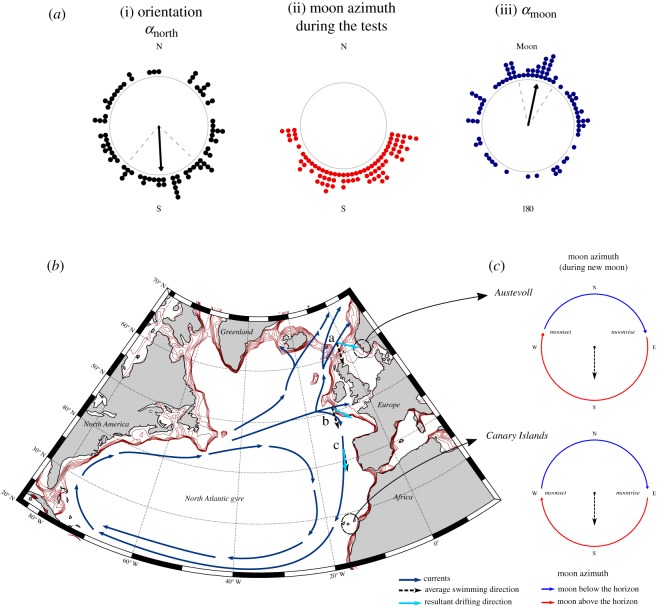Figure 5.
Schematic illustration of the potential advantages of the moon-driven orientation during the migration of European glass eels (Anguilla anguilla). (a) Pooled data of collective orientation (αnorth) (i), moon azimuth during the tests (ii) and orientation with respect to the moon azimuth (αmoon) (iii) at new moon. The circular plots have the same features as described in figure 5. (b) Map of the North Atlantic Ocean with a simplified schematic representation of the great North Atlantic gyre and the main surface currents in proximity of the European continental shelf (navy-blue arrows). The continental shelf is visible from bathymetric red lines (0–700 m, with 100 m interval between the lines). (c) simplified plots of the moon path at the horizon at Austevoll, Norway (where the experiments were conducted and close to the northern limit of the area of distribution of glass eels), and at the Canary Islands, West of Africa (southernmost point where glass eels are found) during the new moon periods of March–May 2017. The plots show approximate moonrise and moonset with respect to the magnetic north (with around 10° of possible variation). Red arrows show the moon path at the horizon when the moon is above the line of the horizon, and the blue arrows when the moon is below the line of the horizon. Dashed black arrows in (b,c) show the average swimming direction that the glass eels would have swimming towards the direction of the moon when the moon is above the horizon, at new moon (south, as showed by the in situ orientation data displayed in (a)). In (b), we report three possible case scenarios of the drifting direction (sky-blue arrows) resulting from the passive drifting caused by the currents and the moon-driven orientation (south oriented). (b.a) shows that swimming towards the moon could potentially help glass eels to exit the Norwegian Current, enter the North Sea and arrive at the coast. (b.b) shows that the moon-oriented swimming could help the glass eels coming from the Gulf Stream to arrive at the Bay of Biscay, the area with the highest recruitment of glass eels. (b.c) shows that the moon-oriented swimming could help glass eels to reach also the Canary Island at the southernmost point of their distribution.

